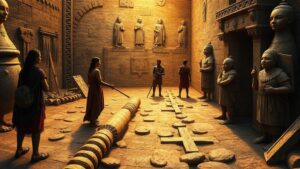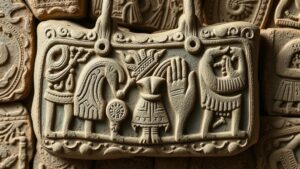Tracing cultural exchanges through artifacts found in desert ruins.
Tracing Cultural Exchanges Through Artifacts Found in Desert Ruins
The study of artifacts discovered in desert ruins offers an invaluable window into the cultural exchanges that have shaped human history. These artifacts not only reveal the daily lives of ancient civilizations but also highlight the intricate trade networks and interactions between different cultures. By examining these findings, scholars can construct a more nuanced understanding of historical narratives that have often been oversimplified or overlooked.
The Significance of Desert Regions in Cultural Exchange
Desert regions, such as the Sahara and the Arabian Desert, have acted as both barriers and bridges in human history. For example, the Sahara Desert is a formidable natural barrier, yet it has also facilitated trade routes that connect sub-Saharan Africa to the Mediterranean world. The most recognized trade route, the Trans-Saharan trade, flourished from the 8th to the 16th centuries, allowing for the exchange of goods, ideas, and culture.
Notably, the discovery of artifacts such as ancient pottery, textiles, and tools from the city of Timbuktu, located near the Sahara, illustrates the extent of cultural interactions. Timbuktu, a thriving center from the 14th century, hosted scholars, traders, and travelers from various backgrounds, resulting in a unique fusion of Islamic, African, and Berber cultures.
Key Artifacts and Their Cultural Implications
Artifacts serve as tangible evidence of historical interactions. Below are some notable examples:
- Inca Knives from the Atacama Desert: Archaeological excavations in the Atacama Desert of Chile have unearthed Incan obsidian knives that suggest trade connections with the coastal peoples of South America. The strategic location of Atacama allowed for the exchange of materials and cultural practices between the Incas and neighboring societies.
- Roman Pottery in the Arabian Peninsula: Discoveries of Roman amphorae and ceramics in Oman reveal trade routes that date back to the 1st century CE. These findings indicate that the Roman Empire extended its influence as far as the Arabian Peninsula, facilitating a flow of goods and cultural exchange that enriched both regions.
- Bronze Age Artifacts in the Iranian Desert: Excavations near the ancient site of Jiroft, Iran, have revealed intricate pottery and metalwork dating back to 3000 BCE. e artifacts highlight the early cultural exchanges between Mesopotamia and the Indus Valley civilization.
Analyzing Trade Networks
Understanding the networks through which these artifacts traveled is crucial for comprehending the scale of cultural exchanges. Trade networks were often characterized by a series of hubs linked by trade routes that stretched across deserts and mountainous terrain. The following points illustrate the nature of these networks:
- Caravan Trade: Camel caravans were the lifeblood of desert trade, transporting goods such as salt, gold, and textiles. e caravans linked West Africa to Europe and the Middle East.
- Seafaring Trade: The Persian Gulfs strategic importance allowed for maritime exchanges between Eastern Africa, Persia, and India. Goods were exchanged widely, fostering cultural interconnections.
- Silk Road Influence: Though primarily associated with land routes, the influence of the Silk Road extended across deserts, facilitating the exchange of silk, spices, and innovative technologies.
Cultural Exchange Beyond Material Artifacts
Artifacts are not merely physical objects; they provide clues to intangible cultural elements such as language, religion, and art. The blending of cultures can be observed in:
- Artistic Styles: The motifs found on pottery and textiles often reveal hybrid styles that combine elements from various cultures. For example, pre-Islamic motifs have been found alongside Islamic designs on ceramics unearthed in desert trade routes.
- Religious Practices: The presence of diverse religious artifacts underscores the coexistence and interaction of different belief systems, such as the syncretism of Zoroastrianism, Buddhism, and Hinduism in trade ports.
Real-World Applications of Artifact Analysis
Current archaeological practices utilize advanced technologies such as satellite imagery and geographic information systems (GIS) to identify potential excavation sites in desert areas. This approach has led to significant discoveries that continue to enrich our understanding of cultural exchanges. For example, recent excavations in the Saudi Arabian desert have revealed ancient structures and artifacts that suggest previously unrecognized trade routes and cultural interactions.
Conclusion and Actionable Takeaways
Tracing cultural exchanges through artifacts found in desert ruins not only enriches our understanding of past civilizations but also illustrates the interconnectedness of human societies throughout history. study of these artifacts serves as a reminder that cultural exchange is a continuous process that shapes our identities and the world we live in today.
As scholars and archaeologists continue to uncover these remnants of the past, it becomes essential to appreciate the complexity of cultural interactions. Engaging with these findings can prompt new questions and inspire further research, ultimately contributing to a deeper appreciation of our shared human heritage.



